Wisteria vines are a popular addition to yards and gardens because of their lush, attractive cascading form and beautiful blossoms. However, they grow and propagate rapidly, and some varieties could be invasive. Wisteria scatters by way of seed pods. That said, we researched whether you should remove wisteria seed pods.
Wisteria vine pods compete for nutrients necessary to ripen. Once they sprout, the seeds will produce new growth several feet away from the main trunk. You should remove them to keep the vine blooming and avoid the plant invading other areas of your yard.
Wisterias provide a stunning backdrop or accent to any landscape. Unfortunately, the growth often becomes difficult to contain. The seed pod characteristic further compounds the problem, making matters worse. Read on and find out how to handle the issue and avoid the plant from taking over your garden.
Why Are Wisteria Seed Pods Significant?
Wisteria reproduces itself by developing seeds in pods that begin to emerge in summer and early fall. They resemble beans or peas since the vine is a member of the legume family. Initially, they start out green and gradually turn brown as they mature.
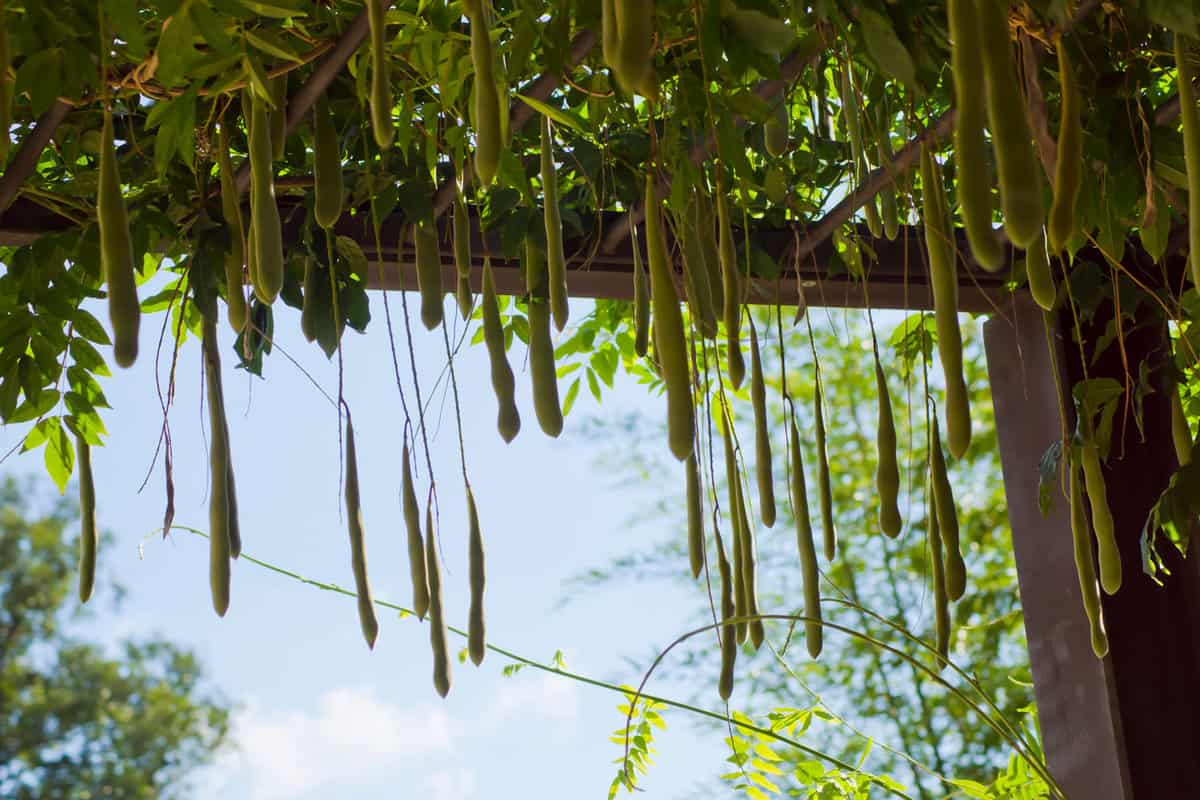
Come late fall, they ripen and literally explode, distributing the seeds several feet in all directions away from the main plant. It is nature's design to enable wisteria to thrive and propagate itself. If the seeds simply dropped to the ground, they would be in competition with the parent vine, other plants, and each other.
Scattering the seeds to farther locations increases their chances of germination, survival, and proliferation.
Why You Should Remove Wisteria Seed Pods
To Keep The Vine Producing Blooms
The plants' energy sources (water, air, light, and nutrients) are utilized to sustain all of their parts. Once the pods emerge and begin to ripen, the seeds divert and consume a considerable amount of resources. As a result, the vine tends to produce fewer flowers.
Remove the pods and prune your wisteria regularly to keep the plant blooming. Cutting dead or damaged branches will also enable the ivy to sustain the rest of the foliage more effectively.
To Avoid Unwanted and Invasive Growth
There are two main varieties of wisteria, and it is easy to distinguish which type you have based on the appearance of the seeds within the pod.
- Fuzzy seeds are of Asian origin and are characteristically aggressive growers.
- Smooth seeds are a native American variety that grows slower and is relatively easier to control.
Once the pods ripen, seeds sprout off in all directions and scatter around your garden. It may take time, but if they are allowed to grow and develop, unwanted vines might invade other plants or structures in the yard.
Eventually, it could scale and kill shrubs, shade out the canopy, choke trees, and climb over fences, walls, and practically anything it could attach itself to. The aggressive Asian variety has been noted to cause considerable damage because of its invasive nature.
To Prevent Accidental Ingestion
All parts of the plant are toxic, and the seed pods are most commonly ingested, especially by children. Wisteria contains the substances lectin and wisterin, which are harmful when consumed.
Symptoms include a burning mouth accompanied by nausea, abdominal pain, and vomiting. In more severe cases, you could collapse.
Pets like cats and dogs, farm animals such as horses and goats are also susceptible to the toxic pods and seeds. Vomiting, sometimes with traces of blood, and diarrhea accompanied by dehydration are some of the signs of poisoning.
Is There An Alternative To Removing The Pods?
Removing the pods before they open will prevent seed dispersal all over the garden. You can retain a select few and tie a bag over the pods, then collect them once they sprout or ripen. This will give you the alternative of planting the seeds in desired, easy-to-control areas.
Deadheading prevents pods from growing outright. It is the process of removing the flower before it totally wilts.
Pods usually emerge once the blooms fade and fall since it signals the need to produce more seeds. It also conditions the plant to keep producing yield over a longer period.
Can Wisteria Cause Damage?
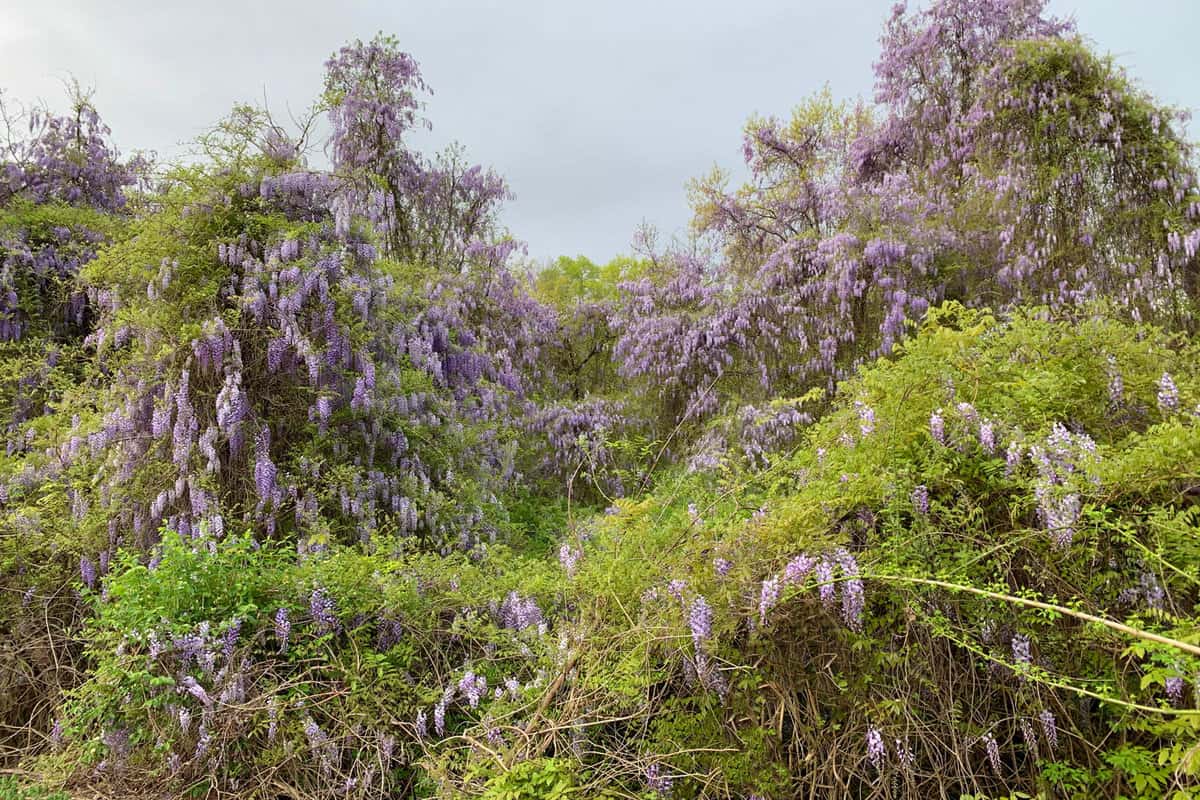
The Chinese and Japanese wisterias are notoriously popular across the United States and are known to be the most invasive of their kind. As a vining plant, it tends to wrap itself around growths and structures within its proximity.
If left uncontrolled, it can do considerable property damage and even destroy an entire ecosystem. Its root system aggressively spreads below ground and cracks pipes and other utility lines.
Underground, they form and develop runners that can spread throughout your yard. These runners produce new shoots, which eventually grow roots. The cycle continues till your whole garden has already been invaded.
How Do You Control Wisteria Growth?
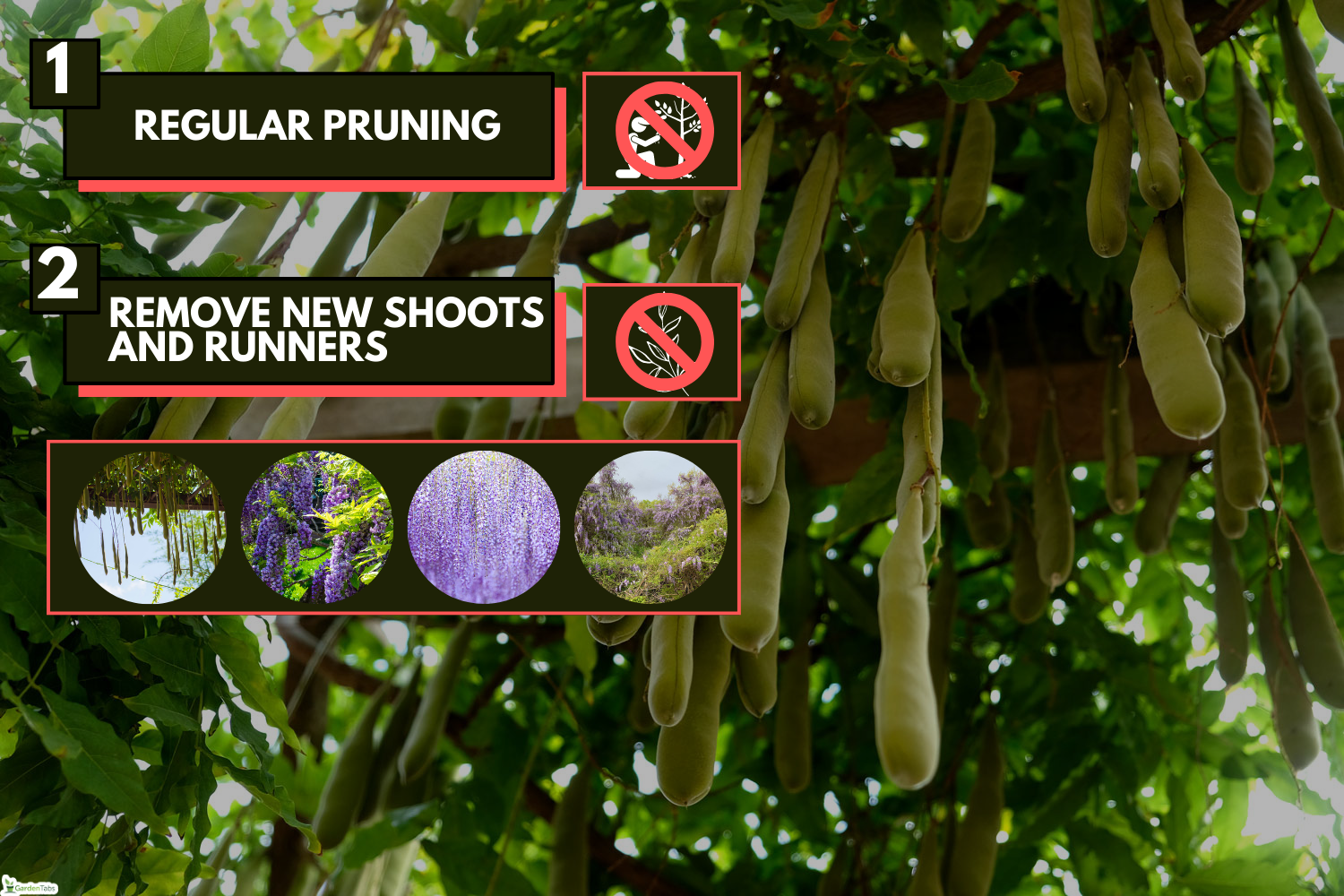
Wisteria could be controlled through regular pruning and pulling off new shoots. Otherwise, the vine could dominate other plants and may even take over your garden. It is best to grow the wisteria vine at a considerable distance from other growths, such as bushes, shrubs, and trees.
Regular Pruning
Pruning wisteria at least twice a year is necessary so you can control its invasive nature. Begin with deadheading during mid-summer once the flowers appear to be wilting. Remove any lateral branches that deviate from the main stem.
In the winter months, wisteria should still be pruned so that the plant will focus its energy on producing flowers for the next growing season rather than on forming and developing new stems.
It is important to make a clean diagonal cut near the nodes of each stem. This way, the plant is able to seal the surface and heal itself faster. If you prune off the branch an inch away from the node, the potential pathogen could enter the exposed portion, eventually harming its health.
Remove New Shoots And Runners
Runners are the reason why new shoots spread and emerge at a distance from the mother plant. It is necessary to prune off these runners to prevent proliferation. They usually appear at the base as long, bright green stems.
Which Wisteria Is Not Invasive?
If you still intend to grow wisteria in your garden, you must opt for the non-invasive species – the American and evergreen varieties.
American Wisteria
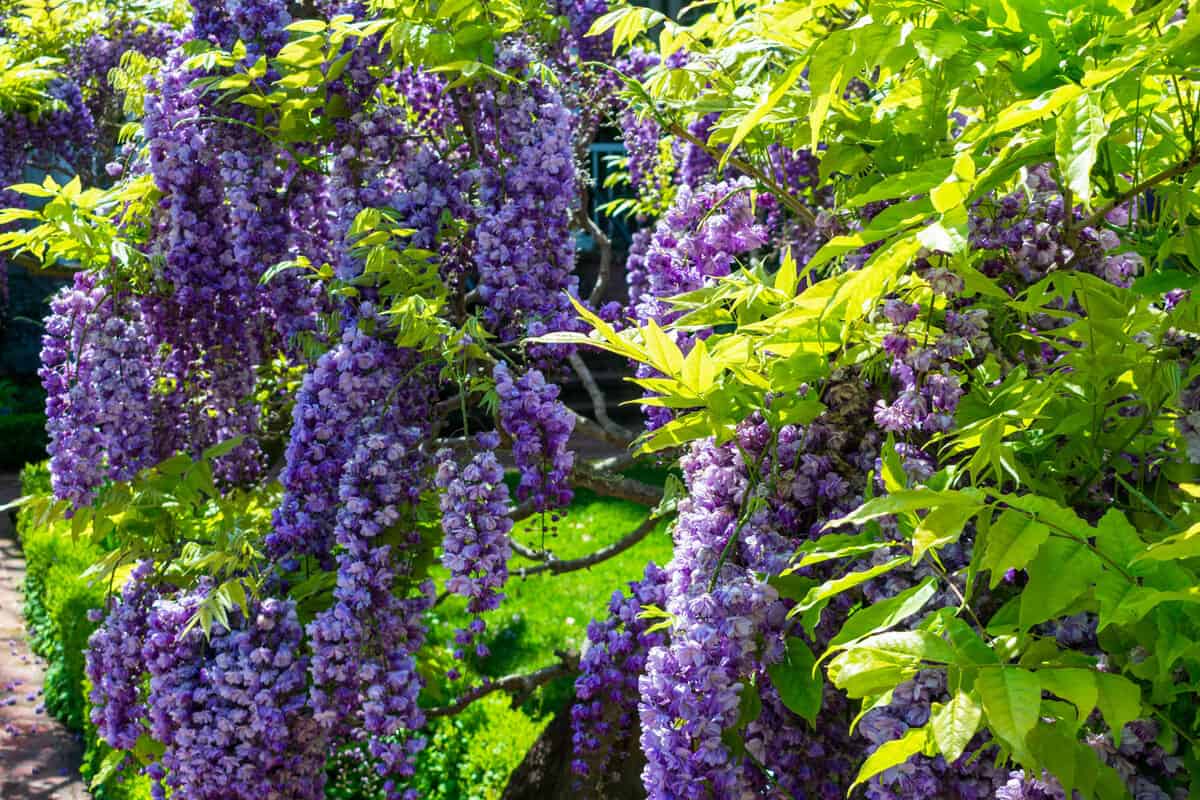
The American variety produces deep blue and purple flowers. Although it is not as fragrant and large as the Asian cultivars, the plant is less invasive and does not require regular pruning and maintenance.
Despite being considered a native variety, its origin can be traced back to the Asian continent. It was introduced in the country during the 1800s and cultivated a new cultivar that is less invasive based on the original plant.
It is environmentally friendly since the vine shelters the larvae of skipper butterflies. Unfortunately, American wisteria can only grow in US hardiness zones 5 to 9. They cannot thrive and survive in areas with hotter climates.

Check out American Wisteria Live Plant Vine on Amazon.
Evergreen Wisteria
Also known as summer wisteria, the evergreen variety is native to China and Taiwan. Although it is not considered a true wisteria, the cultivar produces attractive clusters of flowers that emit the fragrance of cedar and camphor.
The plant can grow up to 30 feet tall, but it can be maintained to your desired height by regular pruning.
For those people living above zone 9, the evergreen wisteria is the ideal variety to grow since it can thrive in warmer regions.
How Do I Get More Flowers On My Wisteria?
Two main factors affect the flowering of wisterias: the general environment and the plant's maturity.
Provide The Plant With Ideal Growing Conditions
To encourage blossoms, it is important to provide your wisteria with optimal growing conditions. Keep the soil moist and well-draining but never waterlogged, ensure the plant receives full direct sunlight every day, avoid overfeeding it with nitrogen-rich fertilizers, and prune off flowers when they appear to be wilting.
Choose Mature Wisteria
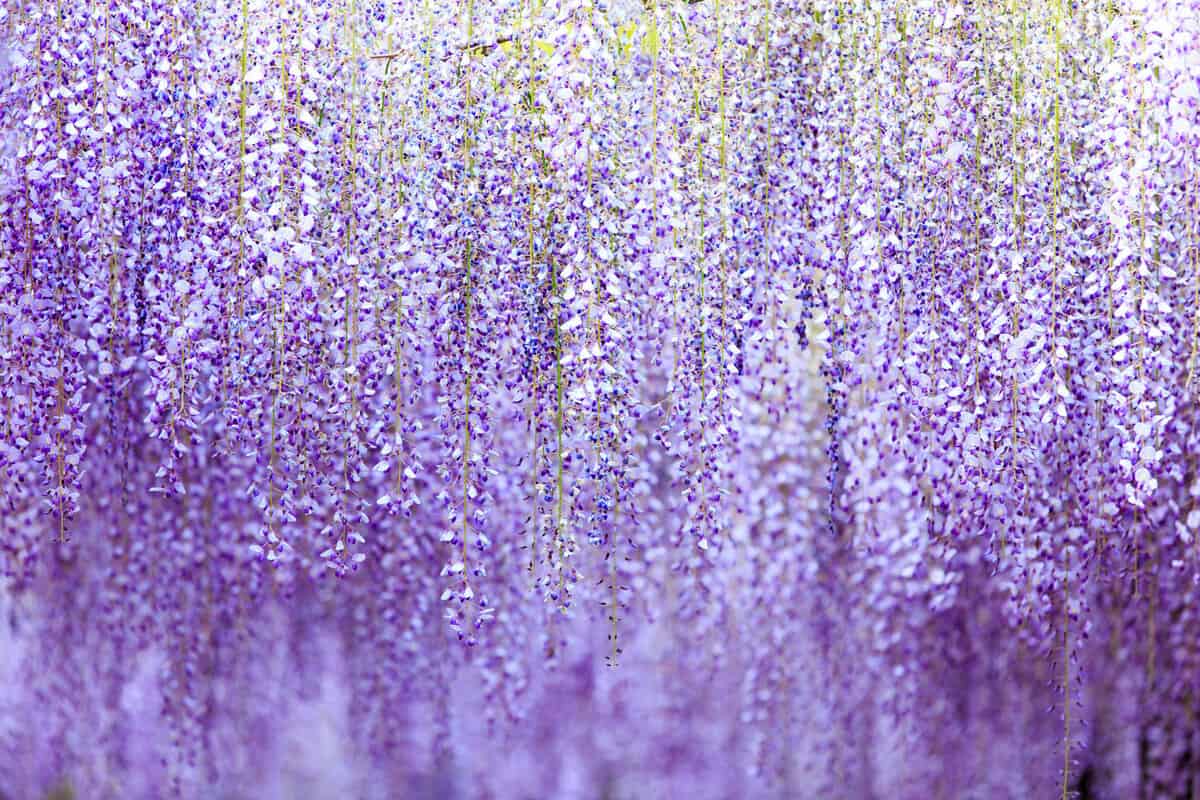
Wisteria undergoes a juvenile period where the plant won't produce flowers for the first three years of its development. Young wisteria focuses all of its energy on stem and leaf formation as well as root development.
If you have grown your wisteria from seeds, it may take a decade before the plant begins producing blooms. It is best to look for mature varieties in nurseries to ensure that the plant is ready for flower production.
Fully-grown wisterias can be identified by looking for buds and seed pods on the plant. You can also ask the nursery owner if they are selling mature varieties.
In Closing
The pods of the wisteria vine can cause the plant to produce fewer blooms once they begin to develop. More importantly, the seeds are toxic to humans and animals.
If they are allowed to ripen and burst, your yard can be filled with unwanted growth.
It is best to remove the pods or perform deadheading to avoid any complications. We hope the post helped you understand why you should remove wisteria pods.
You might also find these topics helpful:
When Does Wisteria Bloom & For How Long? [By Zone]
Does Wisteria Have Invasive Roots? [And How To Control Them]


I just bought a Blue Moon Japanese Wisteria. We are building a pergola for it to grow on. It has nine seed pods on it. Is that a good sign? Should I cut off the seed pods now or wait? Was there flowers where the seed pods are? Please help.
Kim
Yes. “Removing the pods before they open will prevent seed dispersal throughout the garden. You can retain a select few and tie a bag over the pods, then collect them once they sprout or ripen. This will give you the alternative of planting the seeds in desired, easy-to-control areas.”
I asked a question or two earlier. How and where would I find my reply and answer?